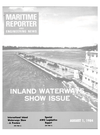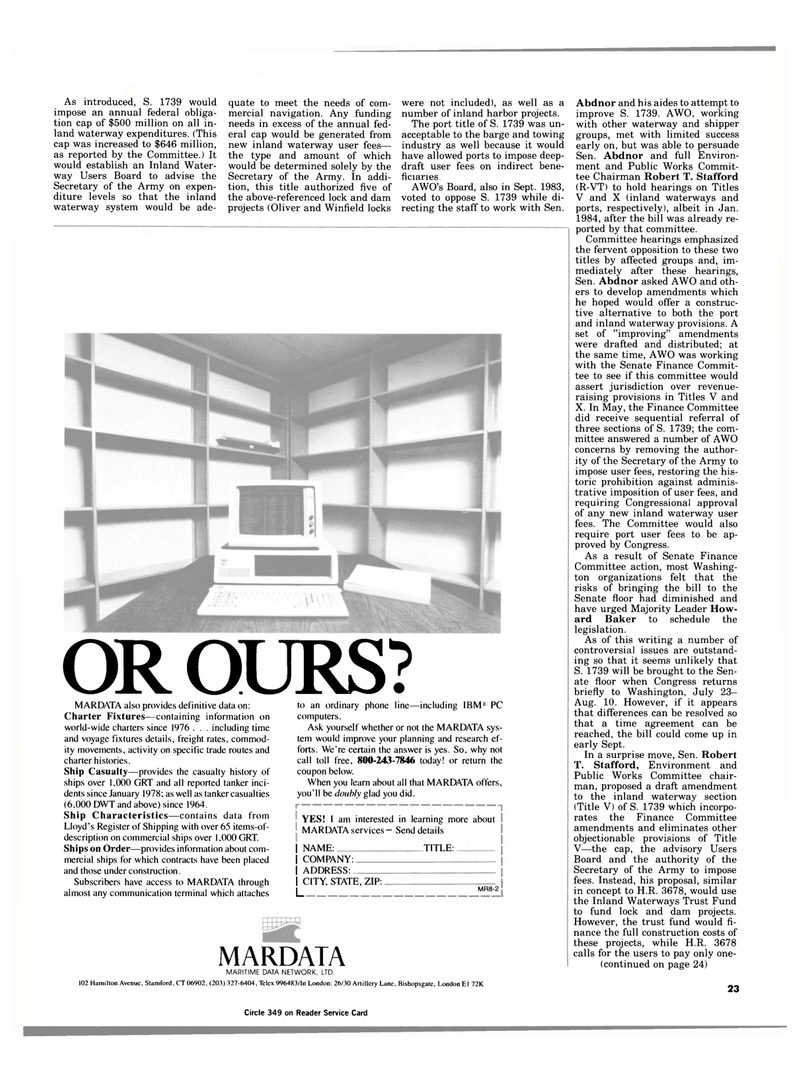
Page 21: of Maritime Reporter Magazine (August 1984)
Read this page in Pdf, Flash or Html5 edition of August 1984 Maritime Reporter Magazine
As introduced, S. 1739 would impose an annual federal obliga- tion cap of $500 million on all in- land waterway expenditures. (This cap was increased to $646 million, as reported by the Committee.) It would establish an Inland Water- way Users Board to advise the
Secretary of the Army on expen- diture levels so that the inland waterway system would be ade- quate to meet the needs of com- mercial navigation. Any funding needs in excess of the annual fed- eral cap would be generated from new inland waterway user fees— the type and amount of which would be determined solely by the
Secretary of the Army. In addi- tion, this title authorized five of the above-referenced lock and dam projects (Oliver and Winfield locks were not included), as well as a number of inland harbor projects.
The port title of S. 1739 was un- acceptable to the barge and towing industry as well because it would have allowed ports to impose deep- draft user fees on indirect bene- ficiaries
AWO's Board, also in Sept. 1983, voted to oppose S. 1739 while di- recting the staff to work with Sen.
Abdnor and his aides to attempt to improve S. 1739. AWO, working with other waterway and shipper groups, met with limited success early on, but was able to persuade
Sen. Abdnor and full Environ- ment and Public Works Commit- tee Chairman Robert T. Stafford (R-VT) to hold hearings on Titles
V and X (inland waterways and ports, respectively), albeit in Jan. 1984, after the bill was already re- ported by that committee.
Committee hearings emphasized the fervent opposition to these two titles by affected groups and, im- mediately after these hearings,
Sen. Abdnor asked AWO and oth- ers to develop amendments which he hoped would offer a construc- tive alternative to both the port and inland waterway provisions. A set of "improving" amendments were drafted and distributed; at the same time, AWO was working with the Senate Finance Commit- tee to see if this committee would assert jurisdiction over revenue- raising provisions in Titles V and
X. In May, the Finance Committee did receive sequential referral of three sections of S. 1739; the com- mittee answered a number of AWO concerns by removing the author- ity of the Secretary of the Army to impose user fees, restoring the his- toric prohibition against adminis- trative imposition of user fees, and requiring Congressional approval of any new inland waterway user fees. The Committee would also require port user fees to be ap- proved by Congress.
As a result of Senate Finance
Committee action, most Washing- ton organizations felt that the risks of bringing the bill to the
Senate floor had diminished and have urged Majority Leader How- ard Baker to schedule the legislation.
As of this writing a number of controversial issues are outstand- ing so that it seems unlikely that
S. 1739 will be brought to the Sen- ate floor when Congress returns briefly to Washington, July 23-
Aug. 10. However, if it appears that differences can be resolved so that a time agreement can be reached, the bill could come up in early Sept.
In a surprise move, Sen. Robert
T. Stafford, Environment and
Public Works Committee chair- man, proposed a draft amendment to the inland waterway section (Title V) of S. 1739 which incorpo- rates the Finance Committee amendments and eliminates other objectionable provisions of Title
V—the cap, the advisory Users
Board and the authority of the
Secretary of the Army to impose fees. Instead, his proposal, similar in concept to H.R. 3678, would use the Inland Waterways Trust Fund to fund lock and dam projects.
However, the trust fund would fi- nance the full construction costs of these projects, while H.R. 3678 calls for the users to pay only one- (continued on page 24) 23
OR OURS?
MARDATA also provides definitive data on:
Charter Fixtures—containing information on world-wide charters since 1976 . . . including time and voyage fixtures details, freight rates, commod- ity movements, activity on specific trade routes and charter histories.
Ship Casualty—provides the casualty history of ships over 1,000 CRT and all reported tanker inci- dents since January 1978; as well as tanker casualties (6,000 DWT and above) since 1964.
Ship Characteristics—contains data from
Lloyd's Register of Shipping with over 65 items-of- description on commercial ships over 1.000 GRT.
Ships on Order—provides information about com- mercial ships for which contracts have been placed and those under construction.
Subscribers have access to MARDATA through almost any communication terminal which attaches
PC to an ordinary phone line—including IBM(I computers.
Ask yourself whether or not the MARDATA sys- tem would improve your planning and research ef- forts. We're certain the answer is yes. So, why not call toll free, 800-243-7846 today! or return the coupon below.
When you learn about all that MARDATA offers, you'll be doubly glad you did.
YES! I am interested in learning more about
MARDATA services-Send details | NAME: | COMPANY: j ADDRESS: _ .TITLE:
I CITY, STATE, ZIP:
I MR8-2
MARDATA
MARITIME DATA NETWORK, LTD. 102 Hamilton Avenue. Stamford, CT06902, (203) 327-6404, Telex 996483/ln London: 26/30 Artillery Lane, Bishopsgate, London El 72K
Circle 349 on Reader Service Card

 20
20

 22
22
